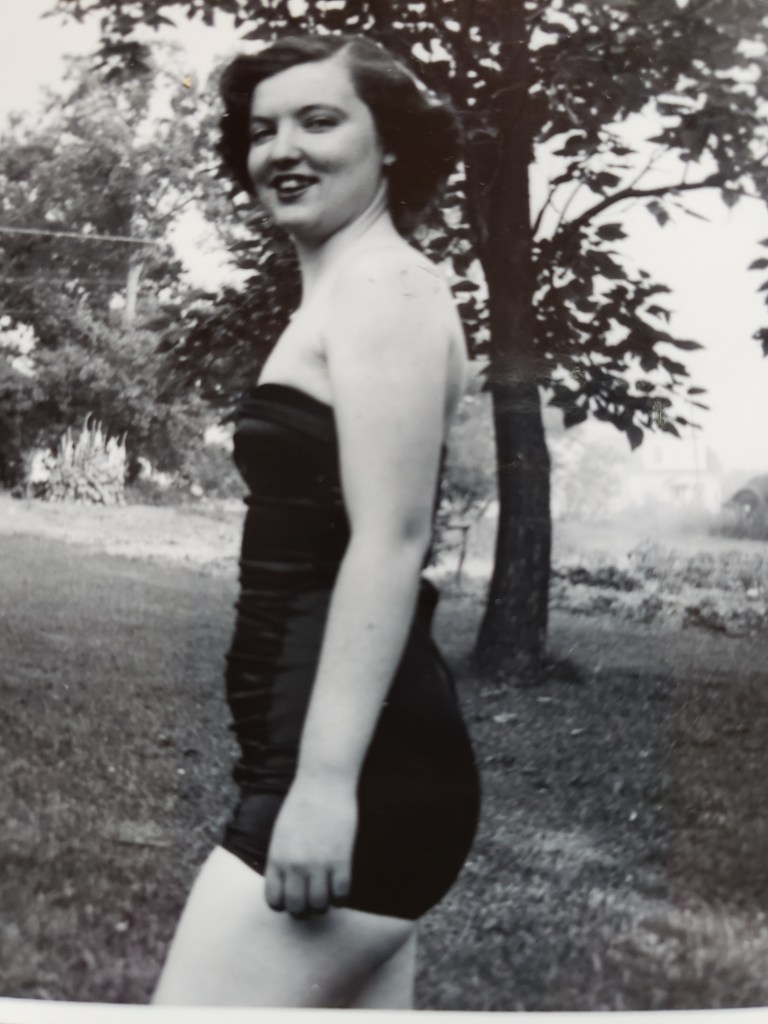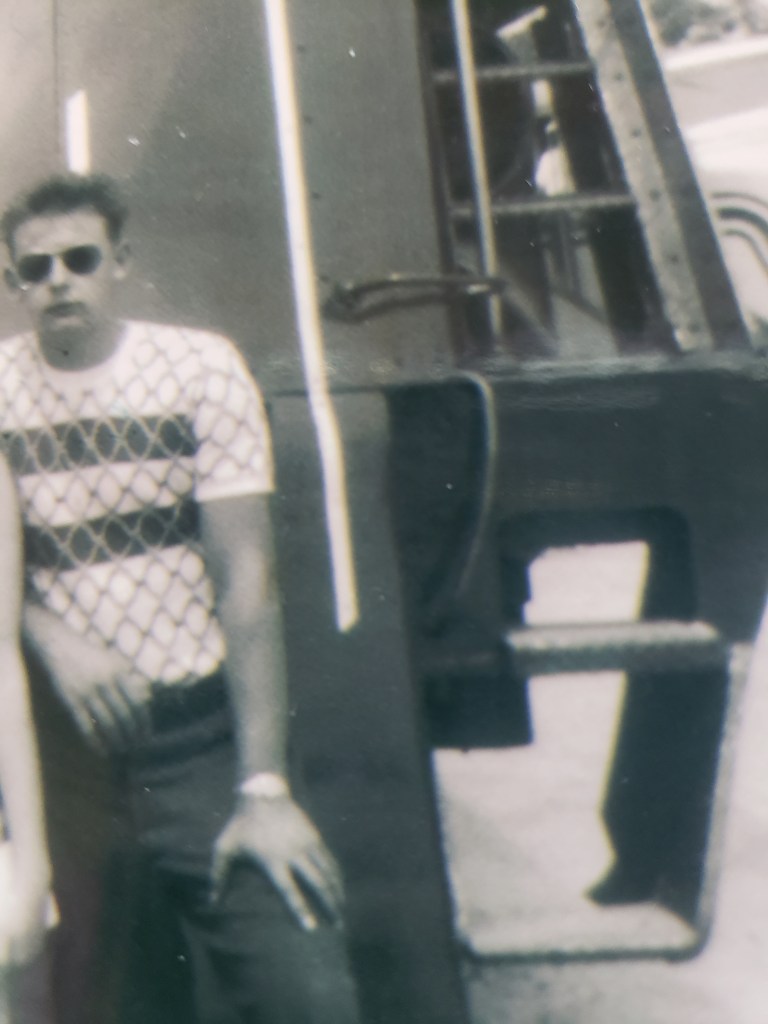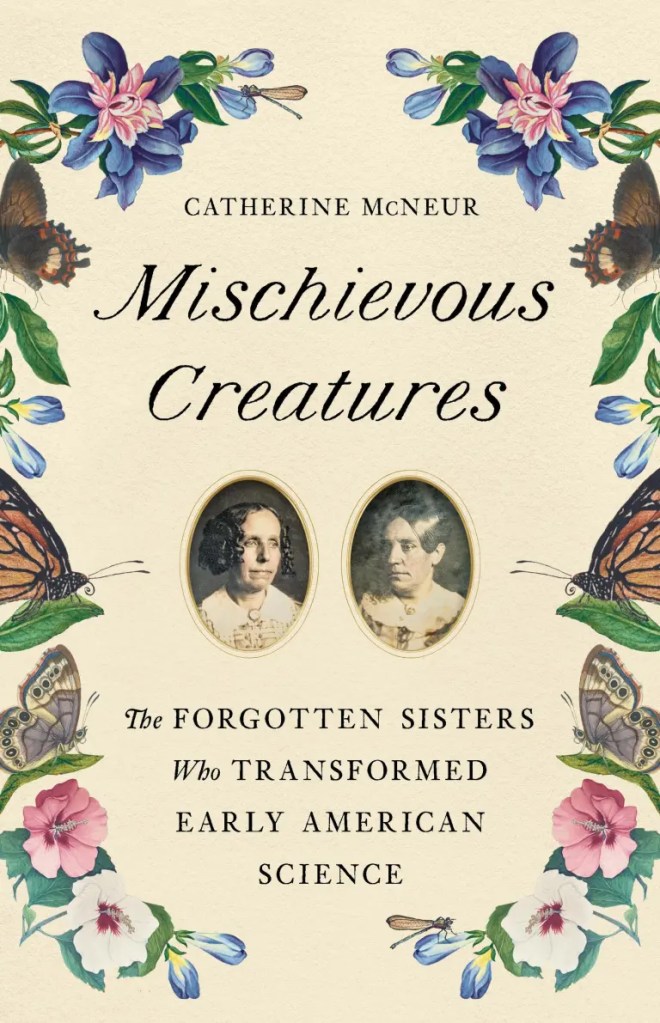I’ve been trying to write this second part of the 2912 Tale since last November. Every time I get to a certain section of it, my brain refuses to move forward. I keep thinking, nope, this is too much. Even though I’ve been writing and publishing for close to thirty years, for this part of the Tale, words fail me. Repeatedly.
Anyway, a quick reminder of the preceding post: Back in October, as I sorted through family pictures with my sister Kathi, I was hit with both memories and momories—my term for the stories our mom (aka Irene junior) told. I know that what I’ve been calling momories are really a form of oral history, the process of verbally passing along information and stories to the next generation. But for me, calling them momories makes their provenance clear and keeps our mom centered in my memories.
As Kathi and I went through those snapshots, we ran across a few of our mom that I didn’t remember seeing before. They had our mom’s careful all-capitals printing on the backs, where she jotted a few identifiers. These jarred a couple of more momories that made me further ponder the relationship between Irene junior and her paternal grandmother, Irene senior.
The first photo is of Irene junior at about a year old, with her father George, Irene senior’s firstborn son, who is holding her hands to help her walk. They are in the yard of the tiny summer home (always called the cottage) owned by Irene senior and her husband Edward (who died before we were born) near a small lake in northern Illinois.*

The second, which I found as startling as the one of Irene senior sitting on a donkey in Capri, shows our mom, probably no more than twenty years old, wearing a strapless swimsuit, smiling at the camera. This picture was probably taken in that same yard at the cottage. Despite the smile, Irene junior did not like warm weather and direct sunshine.

I have a momory about an incident that took place at the cottage probably sometime between the 1940s and early 1950s. Irene junior would have been old enough to be in the room when it happened—the only bedroom in the house, where a small group of female relatives, including her mother and grandmother, changed into their bathing suits before heading down to the lake—but I don’t remember her saying how old.
A younger married woman first raised Irene senior’s hackles by not modestly turning away from the others as she removed her clothing. Flashing portions of her naked body, this woman complained about her husband, said she wasn’t happy in her marriage, and wanted to leave him and get a divorce. Irene scolded the woman—I don’t remember if our mom said it was a niece, perhaps, or a younger cousin—telling her to stop talking foolishly, to behave herself, and go on home with her husband. Our mom related that the young woman felt properly chastised and indeed continued in her marriage, never again mentioning leaving her husband. Nana, our mom said in a tone ladened with finality, didn’t approve of divorce, so there was no divorce in our family.
Lately I’ve been considering that momory alongside another one that should be prefaced by this piece of information. At some point early in our parents’ marriage (or maybe just after they’d become engaged—my memory of the momory is faulty here), Nana bought our dad Mike a pair of sturdy leather work boots. Even if this had been a birthday or Christmas present, it was a generous gift and not inexpensive.
I have wondered if the boots might have been Nana’s way of apologizing for a remark she made, not in Mike’s presence, but one all the members of the Berwyn bungalow household probably chuckled about as they gleefully relayed it to him. Our mom still laughed about it decades later whenever she brought it up; our dad did something like an eyeroll when she did.
The story went like this: While our mom waited for our dad to pick her up for one of their first dates, Irene senior watched as he got out of his car and headed up the concrete front steps of the bungalow. She noted his appearance—loose-fit khaki pants, a Hawaiian-style shirt, dark sunglasses, probably a cigarette in his hand—and announced, “A hoodlum’s come to pick up our Irene.”

(Mike, about 10 years before he met Irene junior, cultivating that “hoodlum” appearance.)
Nana must have changed her mind soon after having an actual conversation with our dad. The two of them ended up liking each other. The work boots she bought for him were a thoughtful gift. Mike learned land surveying in the army, a trade he continued in civilian life, and quality footwear made a huge difference to his on-the-job comfort.

(Mike, somewhere in Korea sometime in 1951, wearing boots similar to the ones Irene senior later gave him.)
Our dad kept those boots for the rest of his life, carefully cleaning and polishing the leather, getting the soles and heels replaced when they wore down.** They probably reminded him of Nana and of that early kindness. He cried when she died, our mom told us. We understood the weight of that sentence. We never saw our dad cry so Nana must have been really special to him.
I sometimes think about the momory of that event at the cottage—our mom’s pronouncement that Nana would not tolerate divorce—and the momory of Nana’s first glimpse of our dad that prompted the hoodlum comment which may have led her to buy the boots. Then I imagine the connections among all these, and the subsequent strong bond between our dad and Nana that prompted his tears at her death.
But to explain how I’ve imagined those connections, I’d have to delve into two family secrets of 2912. That’s what brings me to a dead stop every time I reach this point. I’ve tried to write about them, and I still can’t. While the cat has long been out of the bag about both secrets (at least within the family), they are entangled in many other issues that seem too daunting to unravel. So every time, I just stop writing.
Why bring this up now? Well, sorting through those photographs made me think about it. Plus I’m at the beginning-ish stage of a new book project, which involves a lot of research, some of which ends in frustration because of what’s missing. Or what I believe is missing.
Researching and writing biography requires tracking down a variety of sources, including pictures, letters, and memoirs. I rely on not only what other people decided to save in terms of physical artifacts, but also what they chose to write about, whether as notations on the backs of photos, information passed along in correspondence, and/or remembrances included in memoirs and/or autobiographies.
Decisions and choices like these produce silences in the archives leaving researchers to constantly ask how materials have been selected and saved, but also, very specifically, what’s missing and why it might be missing.
I’ve imposed some silences in my family’s archives by saving some photos and pitching others and by sharing some specifically collected and very consciously edited memories and momories.
After Kathi and I finished looking through all those pictures back in October, I headed off for my first major research trip for a book about Jane Grant, co-founder of The New Yorker magazine and lifelong women’s rights advocate. And there, in the vast collection of her papers, I faced silences. More on that in the next post.***

(Jane Grant, c. early 1940s, Jane Grant Photograph Collection, PH141, University of Oregon Libraries Special Collections.)
Some asides:
*Decades later, when our parents Irene and Mike took us to the cottage in the summer, the first thing my dad had to do when we arrived was clean up the outhouse, especially to get rid of the spider webs. None of us siblings would go in there if we saw spider webs. Even in the 1960s, the cottage lacked an indoor toilet. Our mom disliked being at the cottage, probably because, with four children, she had more work to do during what was supposed to be a vacation. But, because of the four of us, our parents could only afford cheap vacations. The cottage was free to use, within a couple of hours’ drive, and was right near a lake that kept us busy during the long summer daylight.
**After Mike died, Charles, my husband, took the boots. They were still in relatively good shape, but after many decades they only fit one pair of feet so had finally outlived their usefulness.
***It’s Women’s History Month, so I hope to post one or two pieces about Jane Grant and what’s been happening with my research. This year, the National Women’s History Alliance has chosen the theme of “Women Who Advocate for Equity, Diversity, and Inclusion,” which is a good match for my Jane Grant project.












You must be logged in to post a comment.